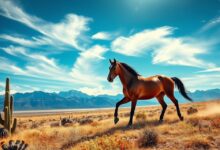Understanding Horse Ride Durations in a Day
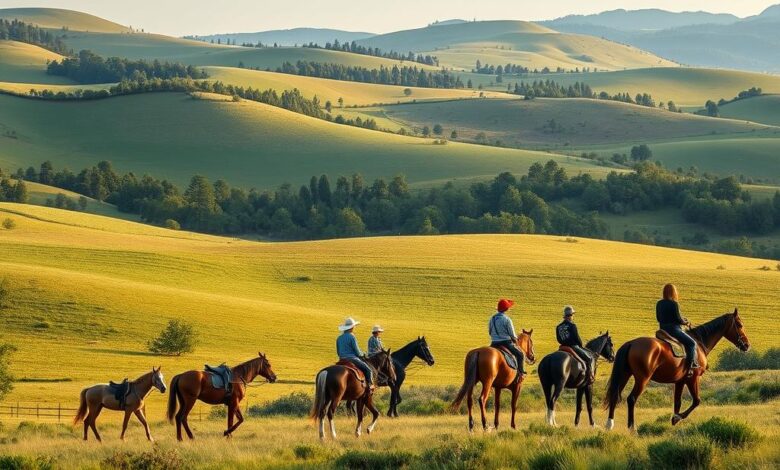
Ever thought about how long a horse can ride in a day? It’s not just a simple question. Many things affect how long a horse can ride. Knowing the optimal horse riding hours is key for both riders and owners. It keeps horses healthy and happy.
We’ll look at how long a horse can ride safely. Different breeds, like Arabians, can go fast and far. But every horse is special, with its own limits and best conditions for riding. Let’s think about what’s right for our horses and how we can care for them better.
Key Takeaways
- The duration a horse can ride varies by breed and individual stamina.
- Proper training and nutrition are vital for endurance riding.
- Monitoring a horse’s health during rides ensures safety and well-being.
- Different terrains and weather conditions influence riding duration.
- Rest and hydration are crucial aspects of long-distance rides.
Factors Influencing Daily Riding Durations
To figure out how long a horse can ride in a day, we need to look at several important factors. These factors help us understand the maximum time a horse can ride and its endurance for daily rides. The horse’s age and health are key to knowing its riding limits. The rider’s experience also plays a big role in managing the ride.
Finally, the terrain and weather conditions are crucial for a safe and fun ride. They help us plan the ride accordingly.
Horse’s Age and Health Condition
The horse’s age and health greatly impact its ability to ride long distances. Young and fit horses can go up to 25 to 35 miles a day. But older horses might find it hard to reach these distances without proper training.
Keeping the horse healthy can help it ride longer. This is important to know how long a horse can ride in one day.
Rider’s Experience Level
A skilled rider can make a big difference in a horse’s daily ride. Experienced riders know how to pace the horse and take care of it during breaks. This helps the horse stay energized.
On the other hand, inexperienced riders might not know how to manage the ride. This can lead to the horse getting tired faster. It’s important to find the right balance between the horse and rider for a successful ride.
Terrain and Weather Conditions
The terrain affects how far a horse can travel. For example, horses can go over 30 miles a day on flat land. But rocky or mountainous areas make it harder to reach these distances.
Weather also plays a role. Temperature and rain can change how long a horse can ride. By adjusting our plans based on these factors, we can ensure a safe and enjoyable ride for the horse.
General Recommendations for Riding Hours
Finding the perfect length for horse riding sessions is key. It makes both the rider and the horse happy. The skill level and goals of the rider play a big role in how long to ride.
Beginner Riders vs. Experienced Riders
Beginners should ride for about 30 minutes to avoid getting tired. Starting with 20 minutes of groundwork and then 10 minutes of riding is great. It helps build important skills and keeps everyone focused.
Experienced riders can handle longer rides, usually 40 to 50 minutes. They can mix up the pace and intensity. This improves the horse’s stamina and agility.
Average Riding Times for Leisure vs. Competition
Knowing the right riding time for fun versus competition is important. Leisure riders might enjoy 25 to 30 minutes of riding a day. This is usually light trotting or groundwork.
But, riders preparing for competitions need longer rides. They might ride for 40 to 50 minutes during the Building Phase. Some sessions can last up to 100 minutes to build endurance.
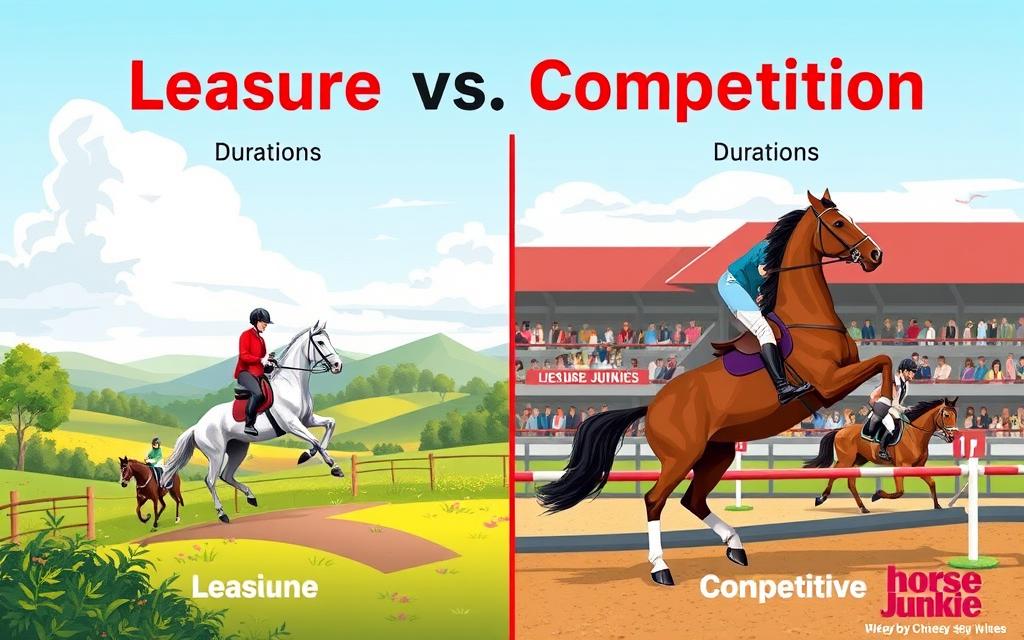
Horse Breeds and Their Endurance Levels
Knowing how far different horse breeds can go in a day is key. The distance a horse can travel varies by breed and training. Each breed has its own strengths, affecting its stamina, speed, and abilities.
Thoroughbreds and Their Athleticism
Thoroughbreds are famous for their athleticism. They come from a racing background and can run fast over long distances. Their training focuses on speed and agility, making them great for long rides.
Draft Horses and Their Strength
Draft horses are incredibly strong. They may not run as fast as Thoroughbreds but can carry heavy loads over short distances. Their strength is impressive, but they’re better suited for tasks needing power, not speed.
Arabian Horses and Longevity
Arabian horses are known for their stamina, often winning endurance events worldwide. They’ve been bred for long journeys, making them perfect for long rides. Their steady pace allows them to cover the longest distances in a day, making them a top choice for endurance riders.
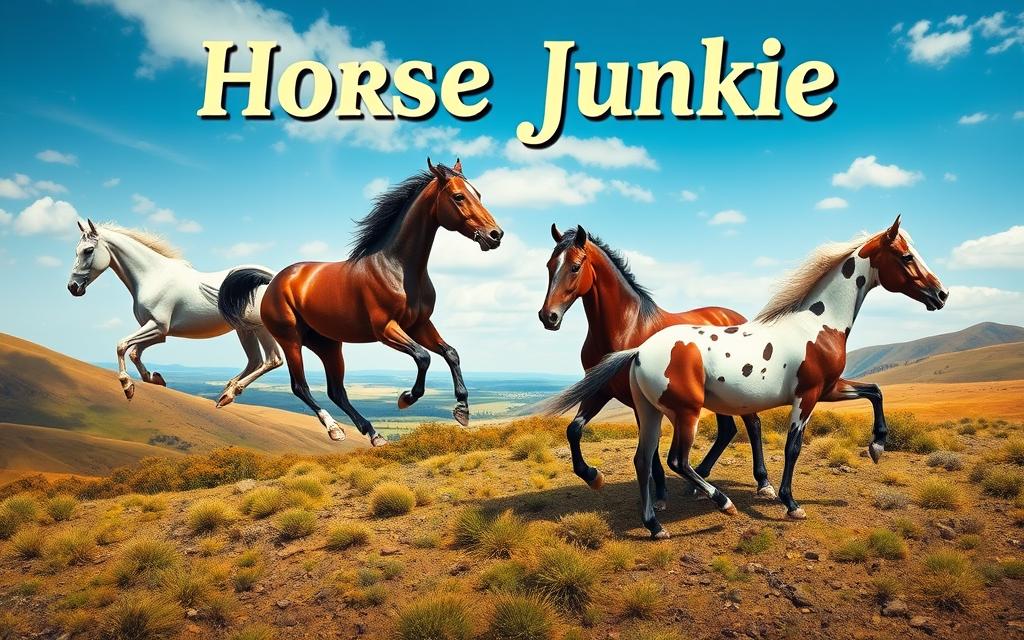
Signs of Fatigue in Horses
It’s important to know when a horse is tired. This helps us keep them healthy and safe during rides. We’ll look at physical signs and changes in behavior that show a horse is exhausted.
Physical Indicators of Exhaustion
While riding, watch for signs that a horse is getting tired. These include:
- Labored breathing: If a horse is breathing harder, it might be tired.
- Increased heart rate: A fast heart rate during a ride can mean a horse is exhausted.
- Muscle stiffness: Stiff muscles after a ride show the horse has been working hard.
- Decreased responsiveness: If a horse seems less alert or doesn’t want to move, it’s likely tired.
Behavioral Changes to Watch For
A horse’s behavior can also tell us if it’s tired. Look out for these signs:
- Reluctance to move: If a horse doesn’t want to start or keep going, it might be too tired.
- Irritability or nervousness: A tired horse might seem grumpy or nervous.
- Decline in appetite: If a horse eats less, it could be feeling unwell or tired.
- Weight loss: Losing 3% to 10% of body weight can mean a horse needs more rest.
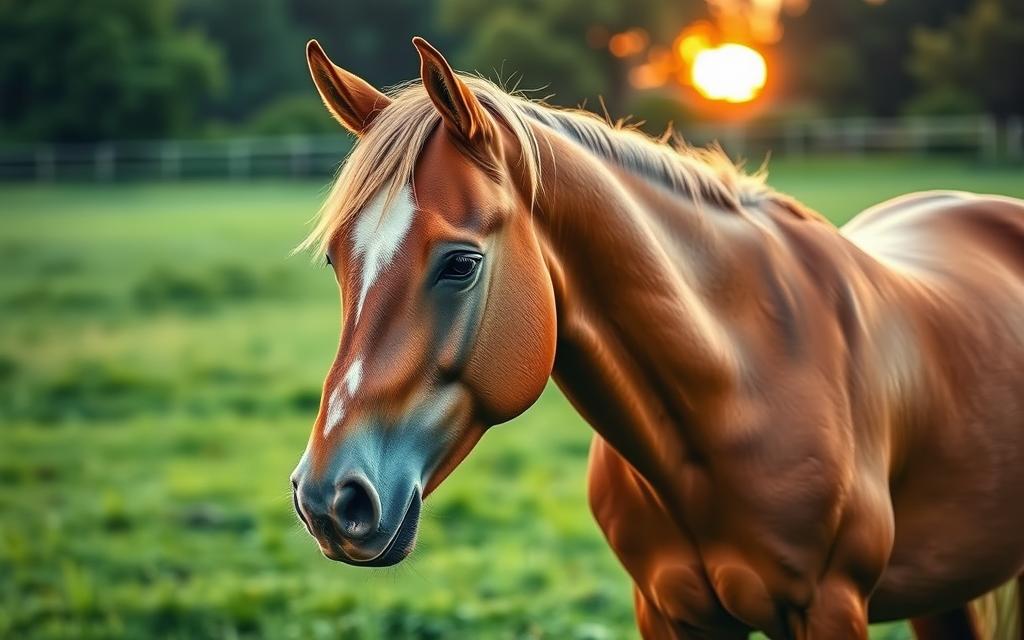
Ideal Riding Conditions for Horses
When planning our rides, we must consider the ideal riding conditions. This ensures both our comfort and our horses’ wellbeing. The time of year and the terrain we choose are crucial. These factors impact our ability to enjoy longer rides and maximize the optimal hours.
Time of Year and Its Impact
The season can greatly affect our riding experience. Spring and fall offer mild temperatures perfect for extended rides. We should avoid extreme temperatures, as they can cause fatigue and stress for our horses.
On hot summer days, early morning or late evening rides are best. This way, we can enjoy pleasant conditions. Winter months may require shorter rides to keep horses warm and comfortable.
Optimal Terrain Choices for Long Rides
Selecting the right terrain is key for long rides. Well-maintained paths and flat surfaces are best for longer rides. We can ride up to 20 miles on roads or level terrain.
In contrast, hilly and mountainous terrains require more energy. They limit us to about 9 miles in challenging conditions. For optimal hours, riding in flat grasslands is better than uneven or rocky trails. This helps our horses conserve energy during long excursions.
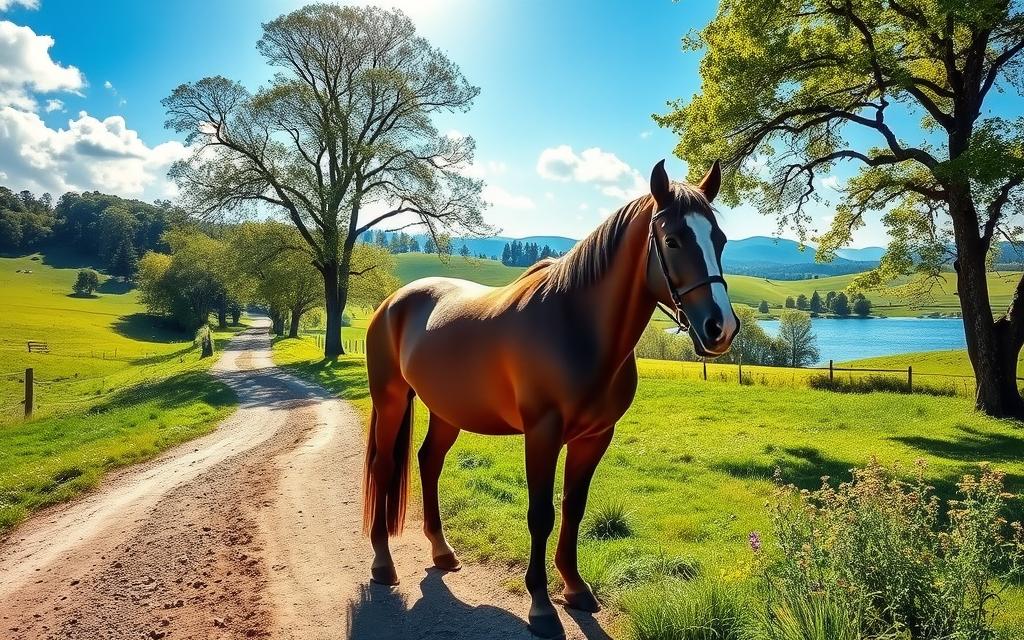
Breaks During Long Rides
Knowing when to take breaks is key to keeping our horses healthy and happy on long rides. These breaks let horses recover, drink water, and take a mental break. Taking these breaks helps prevent overexertion, improving both performance and the ride itself.
Importance of Rest for Horses
Rest is crucial for a horse’s stamina and health. Even though horses can travel far, they need time to rest. This rest helps their muscles heal and prevents them from getting too tired. Finding the right balance between riding time and breaks is vital for a great ride.
How Often to Take Breaks
We usually suggest taking breaks every 7 to 10 minutes of riding. These breaks can last from 2 to 5 minutes, giving horses a chance to relax and refocus. Adjusting the break time based on the ride’s intensity helps keep our horses comfortable and safe.
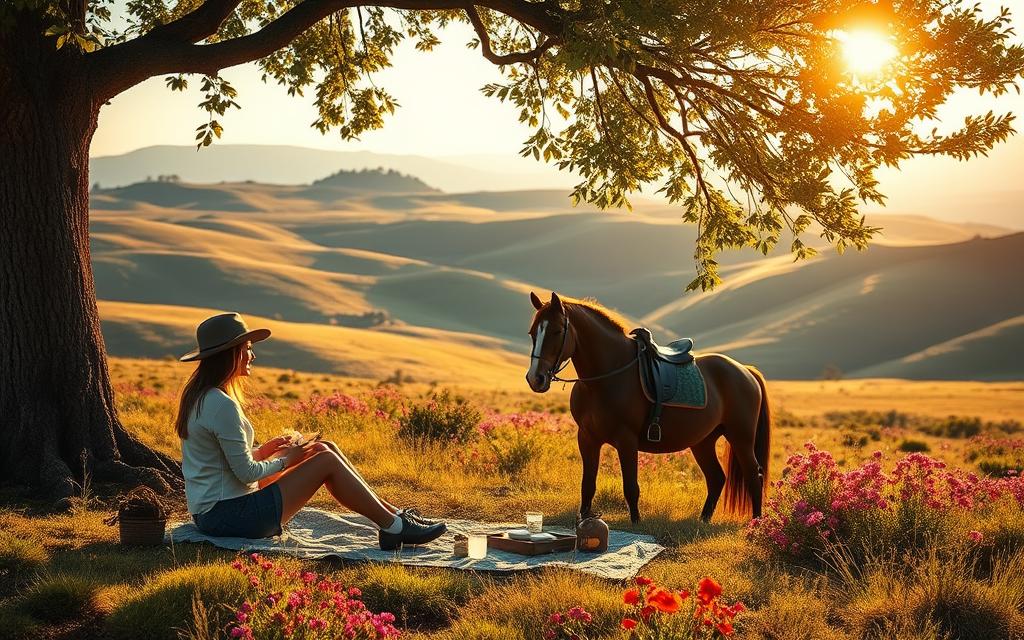
Hydration Needs for Horses on Rides
Keeping horses hydrated is key during rides, especially long ones. Like humans, horses are mostly water, needing enough to perform well. It’s important to watch their water intake to keep them healthy and performing.
Recognizing Signs of Dehydration
It’s hard to tell if a horse is dehydrated. Look for signs like:
- Decreased skin elasticity
- Dry mucous membranes
- Fatigue and lack of coordination
- Physical weakness and irritability
Watching closely is crucial. Signs often show up when dehydration hits 8-10%. Early detection helps prevent serious issues.
Recommended Water Intake
Horses need to drink enough water before, during, and after rides. Here’s what’s suggested:
- Drink one to two cups of liquid an hour before riding.
- Drink half to a full cup every 15 minutes while exercising.
- Drink two glasses of water for every pound lost during training.
On hot days, a 1,100-pound horse should drink about 25 liters (6.6 gallons) daily. Following these tips helps keep them hydrated and performing well.
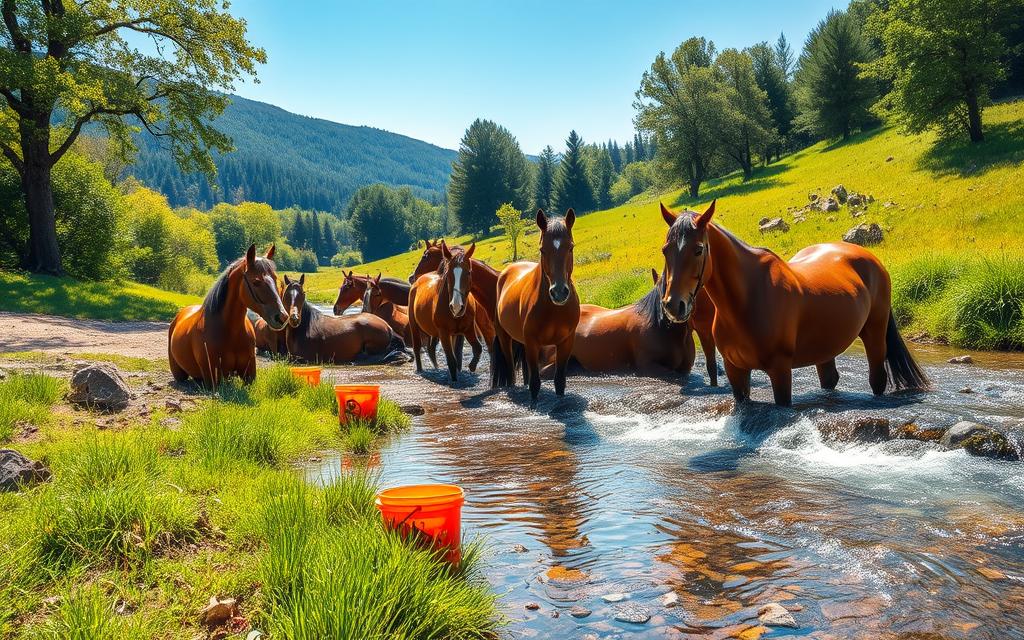
Nutrition Before and After Rides
Good nutrition is key for horse riding performance. We need to focus on what and when we feed our horses. This affects their endurance and recovery.
Essential Pre-Ride Feeding Tips
Right before a ride, it’s important to fuel up. Studies show that feeding a grain meal three hours before intense activities is best. This helps keep energy levels up. Hay is also important for digestion, so make sure it’s always available.
- Feed a grain meal three hours before high-intensity activities.
- Incorporate ample hay to provide necessary roughage.
- Aim for one to two percent of your horse’s body weight in roughage daily.
- Avoid feeding too close to ride time to optimize digestive comfort.
Post-Ride Recovery Nutrition
Feeding after a ride is just as crucial. It helps our horses recover by replenishing energy stores. Feed concentrates about two hours after intense activities to help with recovery.
- Provide concentrates within two hours to aid glycogen recovery.
- Ensure adequate hydration, aiming for at least eight gallons of water daily.
- Monitor body weight and adjust feeding as necessary to meet daily intake.
By following these feeding tips, we can improve our horses’ performance and recovery. This keeps them strong and healthy for every ride.
Planning Multi-Day Rides
Going on multi-day rides needs careful planning. We must think about how long we’ll ride to keep our horses healthy and strong. Good preparation helps us enjoy our trip and take care of our horses.
How to Prepare for Extended Rides
Getting ready for multi-day rides is crucial. Here are some steps to help you prepare:
- Assess the Horse’s Fitness: Check your horse’s health and stamina. A training plan for the ride can help.
- Gather Necessary Supplies: Make sure you have the right gear like saddles and food for the trip.
- Choose Suitable Trails: Pick trails that fit your horse’s endurance and experience. Beginners might like easier trails, while more experienced riders can handle harder ones.
- Plan for Breaks: Include rest days in your plan. This lets both horse and rider rest and enjoy the surroundings.
Setting Daily Distance Goals
Setting realistic daily distance goals is important for multi-day rides. Here’s how to do it:
- Consider the Horse’s Capabilities: Know your horse’s endurance. Most horses can handle 10 to 15 miles a day, but it depends on the terrain and weather.
- Adjust for Conditions: Be flexible with your daily goals, especially in tough or new areas. Your horse might need more breaks.
- Monitor Horse’s Response: Watch for signs of tiredness or strain. Adjust your goals if needed to keep your horse happy and healthy.
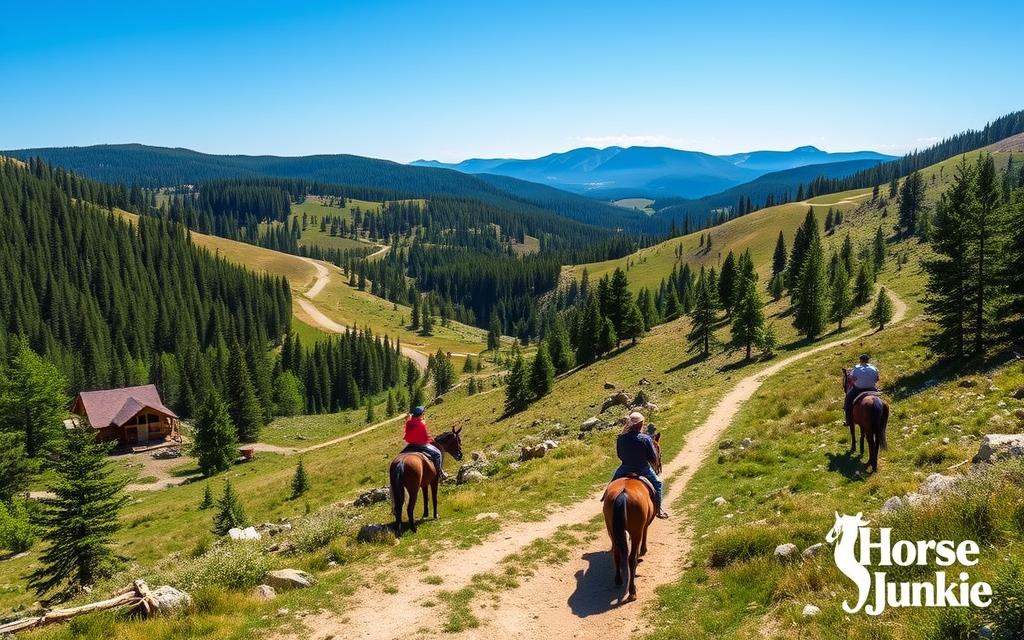
Equipment’s Role in Riding Duration
Proper equipment is key for safe and enjoyable riding. It affects the comfort and performance of both horse and rider. Using the right gear makes every ride better.
Importance of Proper Saddles
Finding the right saddle is vital for horse safety. A bad fit can make the horse tired and affect its performance. A good fit lets the horse move freely and comfortably.
It’s important to check and adjust the saddle often. This is especially true when the weather changes.
Choosing the Right Footwear
Footwear is crucial for both horse and rider. Horse boots protect the legs, while rider boots ensure a good grip. Choosing the right shoes makes rides safer and longer.
Riding Programs for Building Endurance
Building horse endurance is key for their health and performance. We start by slowly increasing riding times. This helps avoid injuries and lets the horse’s muscles get used to the work.
Gradual Increase in Riding Time
We begin with a conditioning program that includes riding four times a week for six weeks. This builds a strong base. As the horse gets stronger, we add trotting to their routine, starting with 10% of each ride.
This can grow up to 50% as the horse gets fitter. Over 4-6 months, our horses can get ready for a 50-mile endurance ride. For a 25-mile limited distance ride, it takes about three months.
Specific Exercises to Enhance Stamina
Using different training exercises is crucial for improving the horse’s stamina. We suggest longer rides, from 15 miles for limited distance to 25 miles for endurance. Keeping an average pace of 6 miles per hour for a 25-mile ride is key.
We also watch the horse’s attitude during training. It should be bright and eager, not evasive or grumpy. A good training program also includes rest and recovery. Well-conditioned horses need breaks to stay fit.
Conclusion: Tailoring Riding Duration to Individual Needs
We know how important it is to adjust riding times for our horses and ourselves. By watching our horses, we learn what they can do and what they can’t. Making plans just for them helps keep them healthy and strong.
As we get more experience, we can make better plans for each ride. This way, we match the ride to what our horse can handle.
Reflecting on Our Riding Experiences
Learning from our rides changes how we approach them. By always checking and changing our plans, we build a stronger bond with our horses. This way, we focus on their health and happiness, not just how fast we can go.
This careful approach makes our rides more rewarding and keeps our horses in top shape.
Making Informed Choices for Horse Welfare
Decisions based on what’s best for our horses shape our riding. Knowing about endurance riding helps us keep our horses well and performing well. The right mix of riding, rest, and recovery keeps them healthy and happy.
As we keep riding, let’s always put our horses’ well-being first. Remember, their health is key to every great ride.
FAQ
How long can a horse ride in one day?
What factors influence how far horses can travel in a day?
What are the average riding times for leisure versus competition?
How do different horse breeds affect endurance levels?
What signs indicate fatigue in horses?
What are the ideal riding conditions for long rides?
How important are breaks during long rides?
How can I ensure my horse stays hydrated during rides?
What nutritional considerations should I keep in mind before and after rides?
How should I plan for multi-day rides?
How can equipment impact riding durations and safety?
What are some effective programs to build horse endurance?
Source Links
- How Far Can A Horse Travel In A Day? l Strathorn Farm
- How Far And For How Long Can A Horse Run?
- How Many Miles Can a Horse Go in a Day? Find Out Now
- How Far Can a Horse Travel in a Day? — The Equine Institute
- How Often Must You Ride to Improve Your Riding?
- How Long Should I Train My Horse Daily? — Jec Ballou Equine Fitness & Performance
- Long-distance horse riding
- Endurance Horse Racing – How Long Can a Horse Run?
- Recognizing and Preventing Exhaustion in Horses
- When Has Your Horse Had Enough? – Speedhorse Magazine
- How far a horse travels in one day
- How Far Can a Horse Travel in a Single Day Under Ideal Conditions?
- Average trail ride length/distance?
- How far can a horse be ridden in a day?
- Equine Odometers: How Far Can Horses Travel in a Day? – Horse Rookie
- How often do you give your horse a break during your ride?
- Hydration & Nutrition for Competition & Hot Weather Riding
- Horse Hydration: Your Questions Answered
- After feeding my horse, how long should I wait to ride or work him? – Official Site of Stacy Westfall
- Horse care guidelines
- Horseback Pack Trips You Don’t Want to Miss | DRA
- How to Condition Your Horse for Equestrian Endurance Riding
- weighing in and after the ride
- Horse riding ins and outs – everything you need to know
- Endurance riding: Everything you need to know at a glance – ClipMyHorse.TV Magazine
- Doing LD (A 25 miler)
- The Physiological Requirements of and Nutritional Recommendations for Equestrian Riders



